|
|
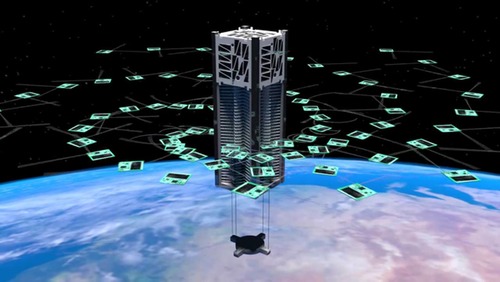 An illustration of the KickSat spacecraft deploying its payload of Sprite satellites, only 3.5 centimeters on a side. A problem with the KickSat’s master time may mean the satellite reenters before it can deploy those Sprites. (credit: KickSat) Among the secondary payloads placed into orbit on last month’s Falcon 9 launch was a CubeSat named KickSat. The spacecraft was one of the first space-related crowdfunding successes: Zac Manchester raised nearly $75,000 on Kickstarter in 2011 for the satellite, far exceeding his goal of $30,000. KickSat’s unique aspect, beyond the source of funding, was its mission. Once in orbit, the satellite would deploy more than 100 “Sprites”: tiny spacecraft that are essentially circuit boards measuring 3.5 by 3.5 centimeters but equipped with a communications system, solar cells, and other components.
The spacecraft’s launch started a timer that, 16 days after launch, would command KitckSat to release the Sprites. If everything had gone as planned, the timer would have reached zero this afternoon, triggering the Sprite deployment. However, in a blog post Saturday, Manchester said that a “hard reset” of KickSat’s main computer on the morning of April 30 also reset that timer. Manchester said that the cause of the reset wasn’t known, but radiation, rather than a power issue with the spacecraft, was the most likely reason.
Assuming that the computer on KickSat doesn’t reset again, the timer would hit zero and release the Sprites on the morning of May 16. However, Manchester noted, there’s a problem: KickSat’s orbit is decaying, and it may reenter before the 16th. On the KickSat mailing list, the latest prediction has the spacecraft reentering just after midnight EDT (0400 GMT) May 16, shortly before the timer reaches zero, but with an error of plus-minus a couple of days.
Manchester said that the KickSat team has looked for ways to speed up the deployment of the Sprites, but there appear to be few options since the satellite isn’t generating enough power for its radio to receive commands from the ground. “While the situation looks a little bleak, there is still some hope that the batteries may recharge sufficiently to command the satellite,” he wrote. “There is also a small chance that KickSat could remain in orbit until the 16th, at which point the timer would set off the deployment as originally planned.” Even if those efforts fail and KickSat reenters before deploying its Sprites, he wrote, “I promise that this won’t be the end of the KickSat project.”
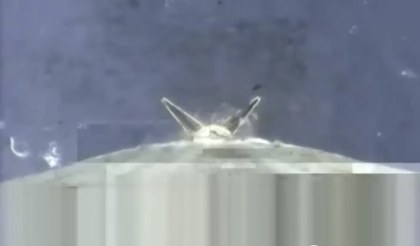 A screen grab from a repaired version of a video released by SpaceX on April 29 shows the Falcon 9 first stage rocket descending to the ocean, its landing legs extended. (credit: SpaceX) At Friday’s press conference in Washington, SpaceX CEO Elon Musk said that the effort to “soft land” the Falcon 9’s first stage in the ocean was a success, even though rough seas prevented them from recovering the stage. Musk at the time said SpaceX had video of the rocket’s descent taken from the stage itself, and would release after making efforts to clean it up.
Late yesterday, SpaceX did release the video, in both its original form as well as a “repaired” version, since the original footage is so garbled as to make it all but impossible to determine what is going on. (The company doesn’t explain why the video is in such poor condition; that is, whether it was a technical problem with the camera or poor transmission of the imagery.) The repaired version isn’t much better, but at 14 seconds into the video, there is a flash of clarity: the stages landing legs extended as the stage descends vertically to the choppy waters below.
SpaceX is providing the raw video files as well in the hopes that others can find better ways to clean up the imagery.
Musk said Friday that SpaceX would make another recovery attempt on its next Falcon 9 launch, of six ORBCOMM satellites. ORBCOMM announced this morning that this launch is scheduled for the morning of May 10 from Cape Canaveral.
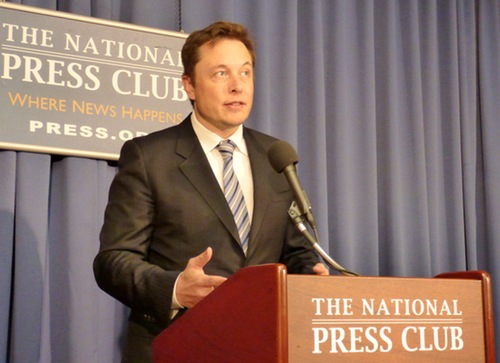 SpaceX CEO Elon Musk speaks at the National Press Club in Washington on April 25. (credit: J. Foust) On Friday afternoon, SpaceX held a press conference in Washington, organized on short notice (emails went out for the 1 pm EDT press conference a little after midnight), and featuring company CEO Elon Musk. The big news for most was Musk’s announcement that the company was filing suit against the Air Force to protest a “block buy” contract it made with United Launch Alliance (ULA) for EELV-class launch vehicles. Musk, though, also had news about the effort the company made on last Friday’s Falcon 9 launch to land and possibly recover the rocket’s first stage.
“I’m happy to confirm that we were able to land—do a soft landing—of the Falcon 9 boost stage in the Atlantic,” Musk said at the opening of the press conference at the National Press Club, “and all of the data that we received back shows that it did a soft landing and was in a healthy condition after that.”
Musk added that heavy seas in the landing area prevented ships from getting out to the site, and that the stage was destroyed by those rough seas. However, even though SpaceX was not able to recover the booster, he said the data they received was “very clear” that the stage did a vertical, powered “landing” on the ocean surface, and remained upright for at least eight seconds, when telemetry from the stage was cut off. In addition, he said the stage’s landing legs also all deployed as planned.
“I gave it sort of a 40 to 50 percent chance of working,” he said of the landing test. “I was actually pleasantly surprised by the fact that the legs deployed and landed… That’s a better outcome than I had expected.”
Musk did not have any photos or video of the stage’s descent and landing to show at the press conference. He said there was a poor-quality video feed from the stage that the company was trying to clean up; he indicated that the company would post the video on its website in the near future and “crowdsource” efforts to improve its quality.
“This is a really huge milestone for SpaceX and certainly for the space industry,” he said. “No one has ever soft-landed a liquid rocket boost stage before. This bodes very well for achieving reusability.”
SpaceX plans to try this water landing test again on the next Falcon 9 launch, of several ORBCOMM satellites, planned for mid-May from Cape Canaveral. Musk said SpaceX would take several steps to have “a much greater probability” of recovering the stage, including securing much larger boats to help in the recovery effort. The stage would also come down closer to shore on this flight, as the ORBCOMM satellites will go into a different orbit than the International Space Station-bound Dragon spacecraft launched last week.
Musk reiterated previous comments by himself and other company officials that SpaceX hoped to be able to return a stage to land by the end of this year, and perhaps refly that stage next year. He said SpaceX has been in discussions with range officials at Cape Canaveral, identifying several potential sites where the stage could come back. “They’ve actually been really helpful,” he said of the launch site’s range safety staff. “At first we were concerned that range safety might be obstructionists, but they’ve actually been really helpful and supportive.”
Later in the press conference, Musk also appeared to indicate that SpaceX’s preference for a commercial launch site was a site on the Gulf Coast near Brownsville, Texas. “We’re also developing a launch pad on the south coast of Texas, near Brownsville, and we’re waiting on the final environmental approvals for that,” he said. “We’ll probably have that site active in a couple years.”
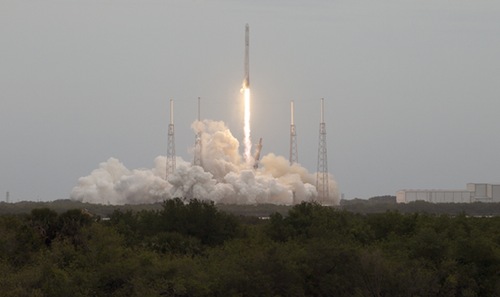 A SpaceX Falcon 9 v1.1 carrying a Dragon cargo spacecraft lifts off from Cape Canaveral, Florida, on Friday, April 18. It successfully placed a Dragon cargo spacecraft into orbit. (credit: NASA/KSC) Despite a foreboding weather forecast, conditions were good enough at the right time Friday afternoon for SpaceX’s Falcon 9 v1.1 rocket to lift off successfully from Cape Canaveral, Florida. The rocket lifted off in its instantaneous launch window at 3:25:22 pm EDT (1925:22 GMT) and placed the Dragon spacecraft into orbit about ten minutes later. The Dragon separated, deployed its solar panels, and is on track to arrive at the International Space Station early on Easter Sunday, with grappling scheduled for 7:14 am EDT (1114 GMT).
“Everything looks great as far as the ascent phase of the mission,” SpaceX CEO Elon Musk said in a post-launch news conference late Friday afternoon. “The rocket flight was perfect, as far as we could tell.”
Musk did indicate there was a minor glitch with the Dragon itself noticed shortly after being released from the Falcon’s upper stage. “We had some slight initial challenges with Dragon, with respect to enabling some of the thruster quads, but those have been resolved, so it looks like everything’s good on the Dragon front,” he said. Later, he said the issue was with an isolation valve that feeds two of the spacecraft’s four thruster valves, but a backup valve resolved the problem. He said he wasn’t sure if this was related to the valve issues that caused problems for the previous Dragon mission, in March 2013.
Some people watching the launch noticed that, as soon as the Falcon 9’s nine first-stage engines ignited, there was a dark plume that rose up the sides of the vehicle, falling back down a few seconds later as the vehicle lifted off the pad. Musk said he believed that was linked to dousing the pad with water shortly before launch. “Essentially, what happened is we splashed dirty water on ourselves,” he said. “A little embarrassing, but no harm done.”
Besides launching the Dragon on the third of twelve contracted cargo missions to the ISS, many were interested in SpaceX’s effort to try and “land” the first stage in the ocean by performing engines burns that would be needed if the stage was going to land, as SpaceX eventually desires to do. As of the Friday afternoon press conference, there was only limited data available, Musk said, because the stage went over the horizon from the Cape; additional data collected by aircraft was expected back later this evening.
What data they did collect was promising. “We have good data down to a pretty low level, roughly around Mach 1.1. Everything looks fine, and we’re awaiting additional data to see how the potential landing burn went,” he said. One key aspect of the data they did have on hand, he said, was that they were able to stop the stage from rolling; it was that roll that caused the engines to shut down prematurely on the previous recovery effort last September when the spin pushed propellants to the sides of their tanks.
The weather conditions hampered efforts to support the recovery test: Musk said high seas kept recovery boats away from the landing zone, while NASA grounded a plane it planned to fly to observe the reentry because of icing conditions, NASA associate administrator Bill Gerstenmaier said at the post-launch press conference. Musk, participating in the press conference by phone, left early in order to get updates on data collected during recovery operations.
SpaceX vice president Hans Koenigsmann, also at the press conference, added that the data he saw from the recovery test looked “great” but that he hadn’t seen all of the data yet. He added that regardless of the outcome of this test, including any effort to try and recover the first stage after splashdown, they would likely do another, similar test on their next mission, carrying several ORBCOMM satellites, planned now for mid-May.
Update 8:30 pm: From a couple of updates from Elon Musk, it appears that the first stage of the Falcon 9 did successfully “land” in the ocean, although it has yet to be recovered:
 The Falcon 9 rocket that will launch the next Dragon spacecraft is shown in its hangar in a photo released by SpaceX last month. This is the first Falcon 9 to feature landing legs on its first stage. (credit: SpaceX) SpaceX is set to make another attempt to launch its Falcon 9 v1.1 rocket on an ISS cargo resupply mission. Launch is scheduled for 3:25 pm EDT (1925 GMT) and while the rocket is ready, weather remains the key issue. Forecasts continue to call for only a 40-percent chance of acceptable weather, and as of the publication of this post, the range was still “no go” because of weather. However, NASA officials said earlier Friday that they would be able to find a “hole in the weather” allowing the launch to go ahead.
When the launch does take place—be it today, tomorrow, or next week—it will be closely watched, and not just by spectators at Cape Canaveral and the usual radars and other tracking assets used for any launch. That’s because of SpaceX’s efforts to attempt to recover the vehicle’s first stage, testing maneuvers to slow down and “land” the stage, albeit over the open ocean and not on land.
“When they do those braking maneuvers to come back and land on the surface of the ocean, those braking maneuvers will be supersonic thruster firings, which will be very similar to what we’ll have to do for braking for a large mass going into Mars,” said Bill Gerstenmaier, NASA associate administrator for human exploration and operations, in a presentation to a committee of the NASA Advisory Council on Monday, before that afternoon’s SpaceX launch attempt was scrubbed.
He said NASA’s Langley Research Center would be flying three aircraft to observe those maneuvers, collecting data to incorporate into their Mars technology developments. “So we’re actually getting data tonight to help us inform and get us ready for the entry, descent, and landing challenge of going to Mars,” he said. It wasn’t clear if the aircraft would also be on station for the launch today, given the weather conditions.
While NASA watches from the air, the Russians may be watching from the sea. The Russian vessel Nikolay Chiker has been lurking in the waters off the coast from Cape Canaveral, the blog The Aviationist reported Thursday, appearing in March for earlier launch attempts and returning in time for the latest attempts. Some speculate the ship is there to monitor the Falcon 9 launch and stage recovery attempt, although it could be coincidental with other efforts, such as monitoring naval bases.
SpaceX CEO Elon Musk knows the Russian vessel is there, and whimsically asks if they pitch in:
As expected, SpaceX and NASA announced Wednesday that they have rescheduled Monday’s scrubbed launch of a Falcon 9 v1.1 carrying a Dragon cargo spacecraft to Friday, with the launch scheduled for 3:25 pm EDT (1925 GMT). A backup launch date is Saturday at 3:02 pm EDT (1902 GMT). As of Wednesday, forecasts still called for only a 40% chance of acceptable weather on Friday, increasing to 70% on Saturday.
SpaceX also shared some additional details about the scrub, which was announced more than an hour before the scheduled liftoff time Monday afternoon. “During Monday’s launch attempt, preflight checks detected that a helium valve in the stage separation pneumatic system was not holding the right pressure. This meant that the stage separation pistons would be reliant on a backup check valve,” the company said in a statement. “No issue was detected with the backup valve and a flight would likely have been successful, but SpaceX policy is not to launch with any known anomalies.” Space X added they are replacing the faulty valve and performing other checks on the vehicle.
If the launch slips past Saturday, though, it’s possible this particular mission could face an even longer delay. Speaking at a meeting of the NASA Advisory Council (NAC) in Washington on Wednesday, Bill Gersetenmaier, NASA associate administrator for human exploration and operations, indicated that further delays might see NASA instead press ahead with a May 6 launch of an Orbital Sciences Corporation Cygnus cargo spacecraft on an Antares rocket from Virginia.
“We have a flight we’re trying to get off this Friday,” Gerstenmaier said of the upcoming Dragon launch. “If that doesn’t occur, we’re going to use the Cygnus vehicle on May 6. So I’m kind of double booking two launches at once for a little while until we see what actually occurs, because we’re getting low enough on supplies on board station that we’ve got to get something to station in the next couple of months.”
He added that if the Dragon launch does go off as scheduled this Friday or Saturday, NASA would delay the Cygnus launch until June 9.
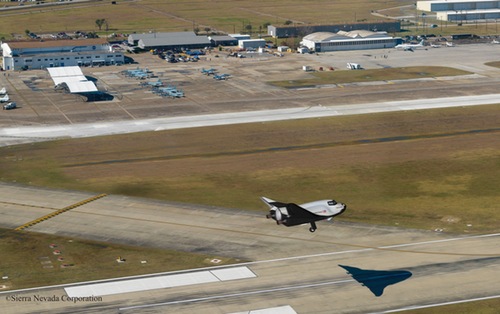 Illustration of a Dream Chaser vehicle landing at Ellington Airport in Houston. Sierra Nevada Corporation and the Houston Airport System agreed April 10 to study the feasibility of using Ellington as a landing site for the vehicle. (credit: SNC) Ellington Airport in Houston is a former military base best known as being the airfield used by NASA astronauts at the nearby Johnson Space Center (JSC) for training flights on their T-38 jets. In the last couple of years, the Houston Airport System (HAS), the agency that operates Ellington as well as the city’s two major commercial airports, has expressed an interest in using Ellington as a spaceport, an interest that extends to doing the groundwork for a spaceport license application to the FAA. But who would be interested in using a facility limited to horizontal takeoffs and/or landings that hasn’t already made arrangements with other facilities, like Virgin Galactic and Spaceport America, or XCOR Aerospace and Midland Airport in west Texas?
Late last week, HAS announced it had found someone who at least showed an initial interest in the site. At a press conference Thursday afternoon at the Rice University Space Institute, HAS and Sierra Nevada Corporation (SNC) signed a letter of intent to study using Ellington as a landing site for SNC’s Dream Chaser orbital crew vehicle. While Dream Chaser will still launch from Cape Canaveral, HAS and SNC will look at the feasibility of having Dream Chaser land at Ellington.
The letter doesn’t commit SNC to using Ellington, but instead will allow the company and the airport authority to study having Dream Chaser use Ellington. At the briefing, SNC corporate vice president Mark Sirangelo, who heads the company’s space systems unit, said the study would cover three areas: a review of the logistics needed to handle Dream Chaser at Ellington, based on actual Dream Chaser data; support for HAS’s spaceport license application; and to “begin a really good dialogue here in Houston about what is the future of space.”
From a basic technical standpoint, it appears that Ellington can support Dream Chaser: the vehicle requires the same runway as a Boeing 737 jetliner, something that Ellington, with runways currently as long as about 2,750 meters (9,000 feet) can handle. The Kennedy Space Center would remain the primary landing site for Dream Chaser, Sirangelo said, but Ellington could be a secondary site, and also allow opportunities to do things like return experiments directly to researchers at JSC or in Houston’s large medical research community.
“The experiments we bring back from the space station, instead of splashing down in an ocean half a world away, land at Ellington and move over to Rice or the Houston Medical Center, and do that within hours of coming off the space station,” he said. “We want to bring that home as benignly as possible and get it to where it needs to go as quickly as possible.”
HAS is currently working on its spaceport license application with the FAA’s Office of Commercial Space Transportation, and has the support of the Houston City Council. “We expect to file the application in June or July of this year,” said HAS aviation director Mario Diaz. “We’re confident that, in January or February of 2015, we’ll be issued the ninth spaceport license in the United States.”
Actually, by the time HAS gets its license early next year, it might not be the ninth site with a license. Eight sites currently have spaceport licenses (“launch site operator licenses,” as they’re officially known), but others, particularly Midland Airport, are working on theirs. Midland has already completed its draft environmental assessment, a document that’s usually the pacing element of a license application.
Whether they’re ninth, tenth, or in some other position, HAS officials indicated SNC’s interest helped bolster their case for turning Ellington into a spaceport. “From our perspective, we can say that being able to have Sierra Nevada land at Ellington Spaceport makes our project a reality,” said Arturo Machuca, HAS business development manager. Many people, he said, had dismissed the spaceport plans as a fantasy or something in the far future. “This project is a reality. It is happening.”
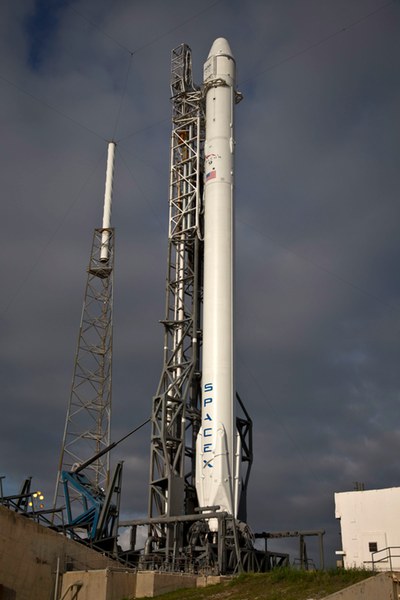 A Falcon 9 v1.1 stands on the pad earlier Monday. The launch of the Dragon spacecraft on the third Commercial Resupply Services (CRS) mission has been postponed until at least Friday due to a helium leak in the rocket’s first stage. (credit: SpaceX) A failed computer on the ISS didn’t delay SpaceX, but a helium leak did. NASA announced at about 3:45 pm EDT (1945 GMT), more than an hour before the scheduled liftoff time of 4:58 pm EDT (2058 GMT), that the launch had been scrubbed for the day for what, at the time, was an unspecified technical issue. NASA and SpaceX later confirmed that there was a leak in the helium pressurization system on the rocket’s first stage.
“A fix will be implemented by the next launch opportunity on Friday April 18, though weather on that date isn’t ideal,” SpaceX said in a brief statement on a page set up to webcast the launch. That’s a reference to the weather forecast issued yesterday, which estimated only a 40 percent chance of acceptable weather for launch on Friday, versus 80 percent today. The launch, if weather permits, would take place Friday at 3:25 pm EDT (1925 GMT).
Neither SpaceX nor NASA have disclosed plans should Friday’s attempt be scrubbed by weather or other technical problems. Should there be a significant delay, it’s possible SpaceX might be pushed back until after the launch of the next Orbital Cygnus mission, slated for May 6. If SpaceX does launch Friday or soon thereafter, that Orbital mission will likely be delayed to early June.
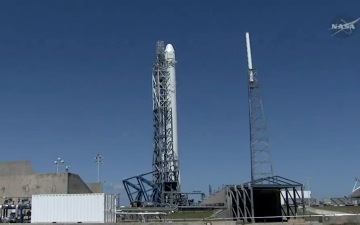 A SpaceX Falcon 9 v1.1 carrying a Dragon spacecraft on the pad at Cape Canaveral, Florida, on Sunday. NASA cleared the launch of the Dragon spacecraft, scheduled for Monday afternoon, despite the failure of a backup computer on the ISS. (credit: NASA) The failure of a backup computer on the International Space Station (ISS) won’t further delay SpaceX’s next cargo mission to the station, which is still scheduled for launch Monday afternoon, officials said Sunday.
The potential for another delay for SpaceX’s third Commercial Resupply Services (CRS) mission to the station, designated SpaceX-3 or SpX-3 by NASA and CRS-3 by SpaceX, arose Friday evening when a backup Multiplexer-Demultiplexer (MDM) computer on the exterior of the station malfunctioned. The MDM backs up other computers used to control exterior systems on the station, including the solar arrays and a mobile transporter on the truss. NASA officials feared another failure could prevent the crew from berthing the Dragon to the station when it arrived there after launch.
At a briefing midday Sunday, NASA officials said they had worked out ways to ensure sufficient redundancy to proceed. “The team concluded the MMT [Mission Management Team meeting] with a go for SpaceX-3,” said Michael Suffredini, ISS program manager. The steps NASA will take will be to move the mobile transporter cart to a new position later today, and to put the solar arrays into a different configuration immediately after the launch to ensure they generate enough power but don’t interfere with the arrival and berthing of the spacecraft, in the event there was another computer failure between launch and Dragon arrival.
Suffredini said that the failed MDM will have to be replaced in a spacewalk, which would take place no earlier than April 22 should Dragon launch on time. The replacement of the MDM with a spare already on the station is a relatively straightforward repair, he said, taking no more than two and a half hours, and would be the only activity during the contingency spacewalk.
Launch is scheduled for Monday in an instantaneous launch window at 4:58:44 pm EDT (2058:44 GMT) Monday, with an 80-percent chance of acceptable weather at launch. Should the launch be delayed, the next opportunity is not until Friday because of orbital mechanics issues; the forecast then is only for a 40-percent chance of good weather.
One aspect of Monday’s launch beyond the delivery of the Dragon cargo spacecraft into orbit will be the test of the recovery of the Falcon 9 v1.1’s first stage. Hans Koenigsmann, vice president of mission assurance for SpaceX and the launch director for the mission, emphasized that the attempt to softly splash down the stage into the Atlantic Ocean is “completely experimental” with the odds of success of only 30 to 40 percent. “This is a really difficult maneuver,” he said of the recovery effort, which involves reentry and landing burns by the first stage after separating, with the water simulating a landing pad. If it works, he said, “we would be super thrilled.”
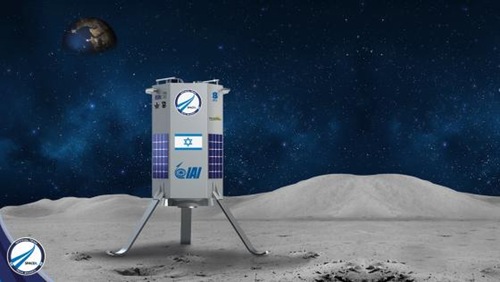 An illustration of SpaceIL’s Sparrow lander on the surface of the Moon. The team’s bid to win the Google Lunar X PRIZE gained traction this month with a $16-million donation. (credit: SpaceIL) There’s now less than 21 months for teams competing for the Google Lunar X PRIZE to win the competition’s $20-million grand prize for landing a spacecraft on the lunar surface, move at least 500 meters, and return HD video and images. Speculation has focused on two US companies, Astrobotic and Moon Express, as the likely front-runners for the competition among the 18 remaining active teams. However, another team made a major step this past week to move towards the front of the pack.
Israeli team SpaceIL announced Wednesday that it has received a $16.4-million donation from the Dr. Miriam and Sheldon G. Adelson Family Foundation. That amount is nearly half of SpaceIL’s estimated budget of $36 million to build and launch their mission. The team’s website states that they have $20 million in “cash and in-kind support” already raised; it’s not clear if this includes the donation.
The Adelson Family Foundation is funded by Sheldon Adelson, a billionaire who made his money with casinos, but is best known today for funding conservative political causes and candidates in the US. “As an entrepreneur, nothing is as thrilling as supporting a group of people who have been told that their dreams cannot be realized,” he said in the announcement of the donation. “We are proud to support Israel and SpaceIL [as they] prove that dreams do come true and that hard work, vision, and dedication are rewarded.”
SpaceIL’s spacecraft, Sparrow, is a small lander based on smallsat technology developed in Israel. The spacecraft doesn’t include a rover but instead will “hop” from one site to another to meet the competition’s 500-meter travel requirement. The team hasn’t secured a launch yet, but the team’s website says that a launch deal “be finalized in the first part of 2014.”
As SpaceIL and other GLXP teams try to get their vehicles ready by the competition deadline, the X PRIZE Foundation itself has worked out a television deal to cover it. Discovery Channel and Science Channel will be the “television homes” for the competition, according to a deal announced April 2. The networks will air a “miniseries event” about the competition, as well as live coverage of winning landing—assuming, of course, a team is able to land on the Moon by the end-2015 deadline.
“When the winning craft touches down on the moon’s surface, it’s going to trigger buzz and inspiration all over the world,” said Discovery Channel group vice president Eileen O’Neill in a statement announcing the deal. “Our intention is to provide a live, front-row seat to history being made,” she added, likening it to other adventure reality programming by the network.
Terms of the deal, including the fee Discovery Channel paid for the rights, weren’t announced. Ownership of media rights for the competition had been a sticking point for some teams in earlier debates about the competition’s Master Team Agreement.
|
|










Recent Comments